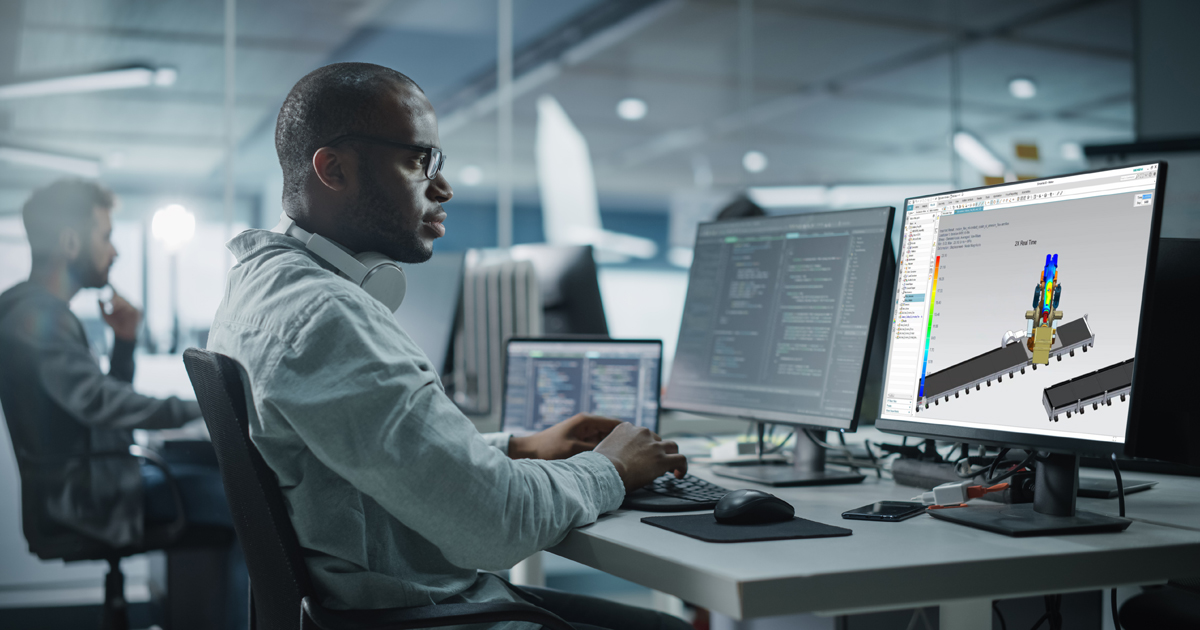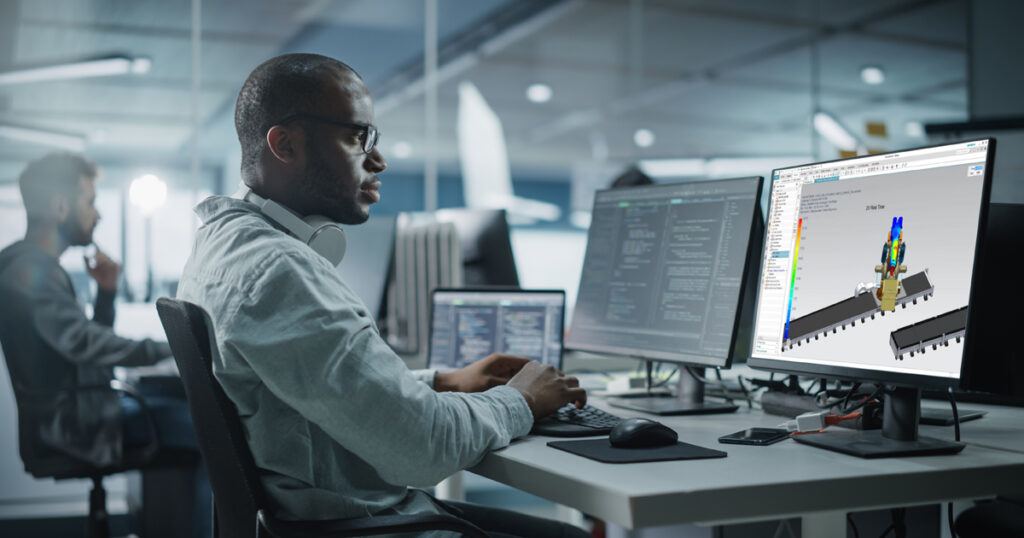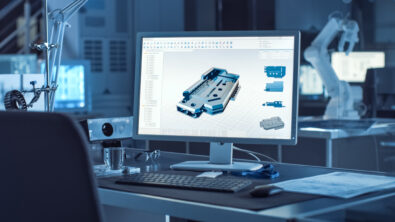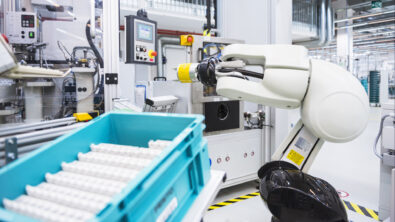Integrated design and simulation improves collaboration within industrial machinery

Getting an industrial machine from the initial design to operation is a long, oftentimes, non-linear process. Frequent customizations have become the new norm, and machine builders need a new way to keep up with regular design changes – whether it’s for performance improvement, new customer requirements or regulatory changes.
Given this type of environment, machine builders and equipment manufacturers can either stretch out delivery timelines or integrate their design and simulation. Further delays aren’t typically an option, but digital tools exist that allow designers and engineers to work more closely together.
At the center of these digital tools lies the digital twin. When designers and simulation experts can work from the same model, different ideas and designs can be tested more quickly, which leads to more innovation in a shorter amount of time.
Design and simulation engineers can use a primary model concept of the same models across tools and keep simulation data in sync with design. Libraries of components built over decades make it easier to simulate various what-if scenarios in the early design phase.
Giulio Camauli, Simcenter Industry Lead, Siemens Digital Industries Software
An integrated approach allows machine builders and equipment manufacturers to streamline inefficient and costly processes while allowing time for new changes. It also opens up new possibilities for more flexible and customized equipment capable of producing more personalized and differentiated products.
In this podcast, Bill Butcher, Rahul Garg and Giulio Camauli from Siemens Digital Industries Software take an in-depth look at integrated design and simulation within the Intelligent Performance Engineering solution. These three experts explain how integrated design and simulation works and how it’s helping industrial machinery companies improve their engineering processes to build better machines, parts and components.
Listen to the podcast
In our last two podcasts, we talked about the evolution of technology within the machinery industry and the key trends that continue to shape the industry today. We also introduced the intelligence performance engineering solution at a high level where you guys discussed three different key differentiators of the solution, which include multiphysics simulation, integrated design and simulation, and closed loop validation.
In our last session, we took a deep dive into how machine manufacturers can benefit from multiphysics simulation, which is a balance of multi attribute engineering to bring a wide range of physics and disciplines together under one umbrella giving the ability to capture not only the complexities of different types of physics, but also enabling multiphysics simulations to study the relationships and the impacts of these simulations across these physical domains.
In this session, I’d like to shift the focus now on the conversation on to the advantages of integrated part design and simulation and why this is so important for designers and simulation engineers to use the same model in one system and keep the simulation data in sync with design. Giulio, let’s start with you today. What are the specific challenges that machine builders are facing where this integrative approach could benefit them?
Giulio Camauli: Nowadays, equipment manufacturers face many challenges to respond to the increasing demand for more flexible and customized equipment that are required to produce more personalized and differentiated customer products. This can add considerable complexity for OEMs. They need to ensure these variation are safe, cost-effective, and performant. So each variation need to be validated before it’s delivered to a customer, and this can be done through multiphysics simulation approach.
Let’s consider an example in a bottle quality test machine. Checking for leaks accommodating the machine for bottle size changes and varying the speed may require physical change to the machine itself. And this requires many simulation and test to be performed to ensure strength, safety, performance, efficiency, and reliability of the machine in which different configuration. It appeared very clear how important that is to be able to pre-assess any new design modifications.
Bill Butcher: So could you elaborate on preassess? What do you mean by that term?
Giulio Camauli: So to be able to verify on the digital twin on your numerical model, the final behavior of the machine in the new configuration. So this will save a lot of time and a lot of cost avoiding any try and error methodology. But be sure that the project, that the design that you will deliver will be running immediately.
Rahul Garg: I think that’s a great point, Giulio because as the customization needs keep arising, the machine builder’s ability to test those customizations become lesser and lesser. Having the ability to design and simulate test but to do the testing and the simulated environment becomes more critical so now you don’t have to worry about trying to make a physical prototype of each variant which can be practically impossible many cases. So having this this integrated design and simulation environment enables you to dramatically reduce the number of physical prototypes you have to build as well.
Giulio Camauli: Yeah you’re right.
Bill Butcher:: But even with this integrated environment you talk about Rahul. Giulio coming back to you. You mentioned customization and you see that it’s just it’s a huge factor facing machine manufacturers today. So help me understand or help our listeners understand why it’s so important to have this integrated design and manufacturing process, and what are some of the risks you see if you’re not doing this today?
Giulio Camauli: Design and simulation engineers can use a primary model concept of the same models across tools and keep simulation data in sync with design. Libraries of component built over decades make it easier to simulate various what if scenarios in the early design phase. As an example, if a designer wants to use a new motor with a higher speed in a machine, they can easily drag and drop the component into the simulation model from the library to see what effect it would have on the overall making design.
So to be sure that we can guarantee the production performance while saving energy for instance. So you have a concurrent performance and through a what if analysis in a conceptual design phase, you can easily see if the new motor that is required to increase the production speed – the throughput rate – can at the same time be more efficient in terms of energy consumption. And this aids in the conceptualizing the overall equipment system design approach much before moving to the CAD design phases. So all these what-if analyses can be performed in an environment where you don’t have yet the 3D design, the geometry of your product, but you just have a functional mockup – a functional model – that is used to assess all the requirements.
Bill Butcher: And I think that that plays well to what I think I believe you talked about in podcast two, which was all the manual processes that are taking place today which I would imagine with such manual processes to do these what if scenarios if you don’t have a solution that’s similar to intelligence performance engineering it would be very very difficult to achieve on any type of scale. So that’s a great example. Thanks. Rahul, you know with Giulio’s response there, to me we’re coming back to the topic of digitalization and the digital twin. It seems to be an overriding topic with any machine manufacturer today. So what is unique about the digital twin in the context of intelligence performance engineering and integrated simulation and design.
Rahul Garg: I think one of the things Giulio highlighted was your ability to do many what-if scenarios and create a library of these functions that you can reuse. So the whole idea behind being able to support your end-customers’ needs can be dramatically improved if we can we use a lot of your systems and components because they’re being tested out, they’ve been validated, you know they work very well. So how do you create that library?
You create that library by making sure that you have a central repository for managing all of your designs, all of your variations, all of your simulations, all of your test results, all of the validations that you may have performed. So this centralized repository becomes a very important value proposition for managing your design information, your simulation information, your test information, and then your real life information. So having all of these different models, the load cases all connected becomes a very critical process to support your constantly rising and customer needs, and your constantly rising demands for reducing the time for delivery and reporting the performance. So having this this ability to manage this in a product lifecycle management tool makes it very easy for companies to deliver the highest performance capabilities for their customers.
Bill Butcher: So Giulio, do you have anything to add to that? Is there any comments that Rahul mentioned there I mean? Are you seeing that that happening today? Or is this again a lofty idea?
Giulio Camauli: The fact that you can use the libraries is of course a safe design process. The fact that you can really rely on validated model of the different component that you can integrate and assemble together into a new architecture is saving not only time and cost, but it’s also increase reliability.
Bill Butcher: Rahul, continuing your comments in a little bit on the thread – on the digital thread – can you talk a little bit further about you know the benefits of the manufacturers you know can achieve by incorporating integrated design and simulation into their manufacturing process?
Rahul Garg: So to me, I think the biggest one is time to market, time to delivery compressing that time. At the end of the day, it’s one of the biggest issues most companies face is being able to respond to the customer needs and being able to deliver the product at the fastest possible time. By bringing the design and simulation and test environments together, you’re able to drastically reduce that overall time.
And then obviously, along with time you’re able to get many more things, improve quality while trying out new design ideas, trying out new concepts, evaluating, making sure that you’re balancing your needs for performance and the needs around even energy and other aspects that typically become critical. So those are some of the key benefits that customers can realize by having this integrated design and simulation environment.
Bill Butcher: So, in complex projects, you know analyst must set up basic simulations, and there’s that closed-loop connection between the simulation model that we talked about. Giulio, with that in mind, are there any examples of companies that have taken this approach and implemented it? And if so, what kind of benefits have they achieved?
Giulio Camauli: We can consider the example of one of our customer Hager group. A German company who is using Siemens solution to optimize extrusion tools. The company had a number of business challenges. For instance, we can consider that they have to develop multi-extrusion tools. They have to optimize the extrusion tool production, and they also need to understand the range that the new tools must cover.
And it is clear that the keys to success are being able to produce flexible solutions to ensure an optimal design and development process and accelerate extrusion through development to be first on the market. By adopting an integrated and scalable design and simulation approach, they have been able to achieve very important results like optimize extrusion tools through the design process to shorten the development cycle to consolidate the development process. I think this is a good example of a customer who adopted the stimulation at design level.
Rahul Garg: I would probably add on that by doing that they were able to obviously reduce that time, but by automating with the workflows right between the design and the simulation people, exploring many tradeoffs – performance tradeoffs – evaluating what-if scenarios. So a lot of that could be done more easily by integrating the design and simulation environments.
Bill Butcher: The Hager story is a good example of why it’s so important to use the same models in one system and keep that simulation data in sync with design to improve those efficiencies you guys both just highlighted. I want to thank you both for the time and information you shared today during this podcast on integrated design and simulation.
I hope you will join us again as we wrap up our series on the intelligent performance engineering solution for industrial machinery. During that podcast we will take a deeper dive into the topic of closed-loop validation and look at how machine builders can validate simulations by capturing and testing the relationship between requirements, functional layouts, logical implementations, and physical implementations. Thank you very much everyone. Until then, we’ll have a great day.
How integrated design and simulation works
With integrated design and simulation, designers and simulation engineers work from one model in a single system. Using a comprehensive digital twin, simulation data stays in sync with design information. This fast-tracks and simplifies the entire development process through better and easier collaboration.
When designers and simulation engineers are able to work more closely, they can simulate multiple configurations quickly and discover which designs offer the best balance of safety, performance, efficiency and reliability. This has become a necessity in a market where manufacturers require more personalized, flexible machines.

The digital twin is the single source of truth for an individual design, and it’s the central piece for improved collaboration. Taking it a step further and thinking bigger, machine builders can use different models to build up libraries of parts, components and entire machines. These libraries are built up over time and make it easier to simulate multiple what-if scenarios quickly very early in the design phase.
A central repository, built from years of collaboration between designers and simulation engineers, reduces the risks companies need to take because they can integrate and assemble new configurations from validated parts and components. It also allows companies to deliver higher-performing machines in a shorter period of time.
The benefits of integrated design and simulation
One of the biggest challenges most companies face is being able to respond to customer needs and still being able to deliver the product as fast as possible. By bringing design and simulation together, companies can reduce time to market.
As machine builders and equipment manufacturers try out new design ideas and concepts, new evaluations get added to their library of information. And while companies continue to balance performance and other product aspects, quality improves through a natural progression.
As the customization needs keep arising, the machine builder’s ability to test those customizations become lesser and lesser. Having the ability to design and simulate tests… in the simulated environment becomes more critical, so now you don’t have to worry about trying to make a physical prototype of each variant, which can be practically impossible many cases.
Rahul Garg, Vice President Industrial Machinery, Siemens Digital Industries Software
A multi-extrusion tool machine manufacturer experienced this firsthand. Once they adopted an integrated design and simulation approach, they shortened their development cycle time and optimized their extrusion tools.
A big part of their success came from automating workflows between design and simulation. These automated workflows allowed them to quickly evaluate a multitude of what-if scenarios and explore different performance tradeoffs before finalizing their design.
Learn more about Intelligent Performance Engineering in this podcast series
The embedded video above is the third of four podcasts on Intelligent Performance Engineering. It provides an in-depth look at integrated design and simulation and how it helps machine builders and equipment manufacturers overcome the challenges they’re currently facing.
The following three episodes discuss Intelligent Performance Engineering and its other aspects:
- Episode 1: What is Intelligent Performance Engineering?
- Episode 2: Multiphysics simulation
- Episode 4: Closed-loop validation
Continue listening to Bill Butcher, Rahul Garg, and Giulio Camauli to find out how Intelligent Performance Engineering solutions can help the industrial machinery industry continue to improve how it’s building new and innovative products in an evolving marketplace.


